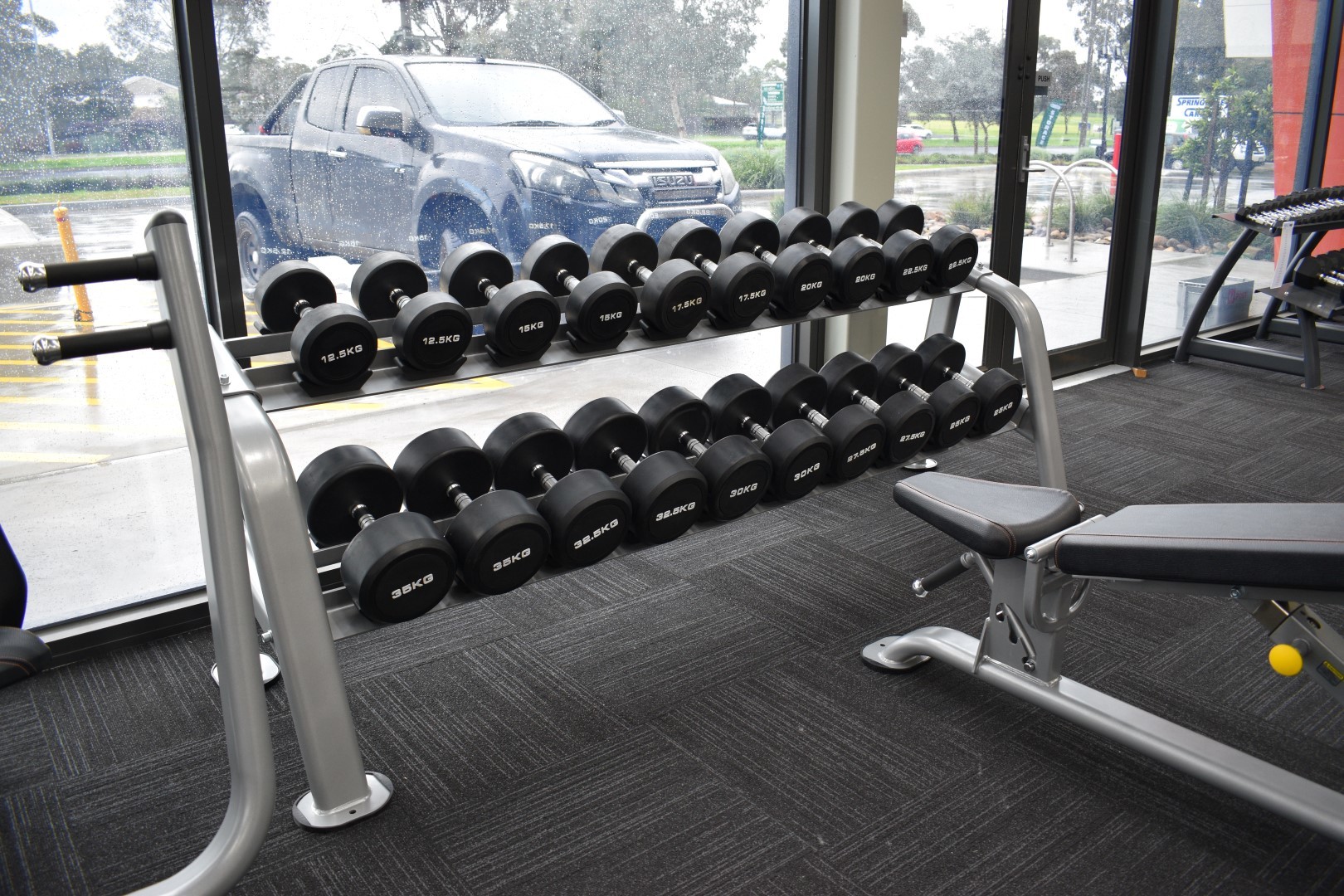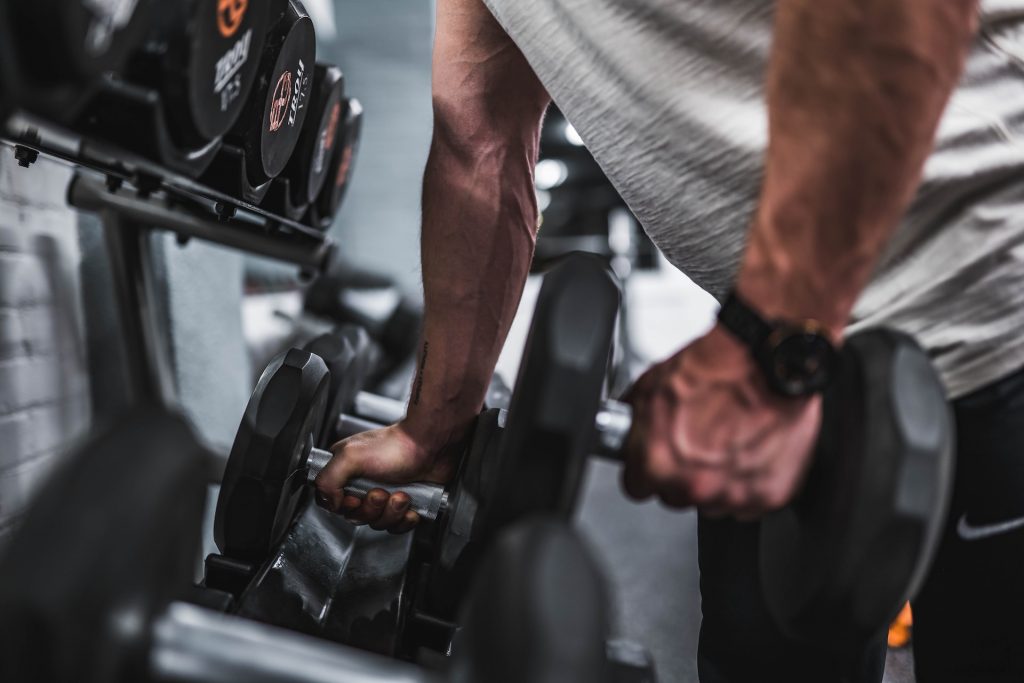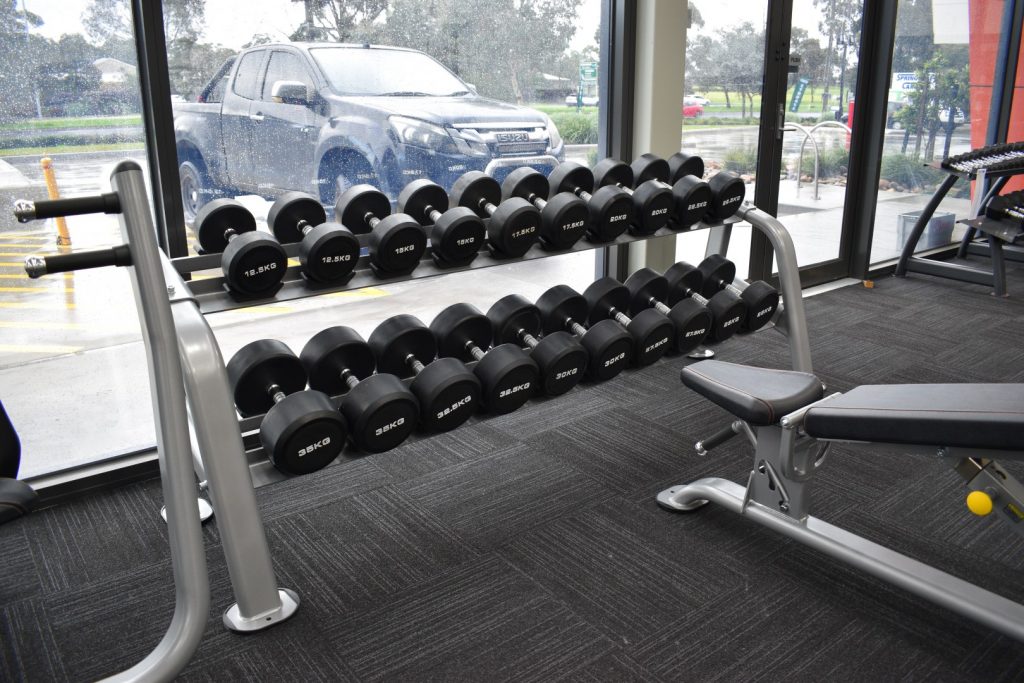
Dumbbells 101: Types, Benefits, and Effective Workouts
Dumbbells are simple yet versatile fitness tools consisting of a handle connected to weight plates. These compact weights come in various sizes and materials, making them a fundamental component of any strength training regimen.
Incorporating dumbbells into your fitness routine offers numerous benefits. They enhance muscle strength, promote muscle balance, and enable a wide range of exercises targeting different muscle groups. Whether you’re a beginner or an experienced fitness enthusiast, dumbbells are essential for achieving your strength and fitness goals.
Dumbbells are straightforward fitness tools designed for strength training. They consist of a handle connected to one or more weight plates. This uncomplicated design allows users to perform a wide array of exercises to target different muscle groups.
Read Also: What Weight Dumbbells You Should Use for Workouts!
Everything You Need to Know About Dumbbells
Common Materials Used in Dumbbell Construction
Dumbbells are typically constructed using various materials, each with its own set of advantages. Common materials include:
- Cast Iron: Known for durability and classic design.
- Rubber-Coated: Offers protection against damage and reduces noise.
- Vinyl-Coated: Provides a comfortable grip and is gentle on floors.
- Chrome-Plated: Has a sleek appearance and is corrosion-resistant.
Key Components of a Dumbbell
Understanding the main components of a dumbbell is essential:
- Handle: The central part you grip during exercises. It should offer a comfortable and secure grip.
- Weight Plates: These attach to the handle and determine the dumbbell’s total weight. Plates can be added or removed to adjust resistance.
- Collars: These secure the weight plates in place, preventing them from sliding during workouts. Safety and stability are crucial here.
D. Popular Brands and Manufacturers
Reeplex is a reputable manufacturer known for producing high-quality fitness equipment, including dumbbells. When looking for reliable dumbbells, consider reputable brands like Reeplex for durability, safety, and performance in your strength training journey.
Types of Dumbbells
A. Adjustable Dumbbells
Adjustable dumbbells are versatile tools with a design that allows you to change the weight by adding or removing plates. This flexibility makes them suitable for a wide range of exercises, from curls to squats. They are an excellent choice for home gyms with limited space.
Advantages and Disadvantages:
- Advantages:
- Space-efficient, as they replace multiple sets of fixed-weight dumbbells.
- Cost-effective in the long run, as you only need one set.
- Ideal for progressive training, allowing you to increase weight as you get stronger.
- Disadvantages:
- May take some time to adjust the weight between exercises.
- Potential for wear and tear on the adjustment mechanism over time.
B. Fixed-Weight Dumbbells
Fixed-weight dumbbells come in pre-determined weights and are ready to use right out of the rack. They are suitable for exercises where you don’t need to change weights frequently, such as lateral raises or tricep extensions.
Advantages and Disadvantages:
- Advantages:
- Quick and easy to use, no weight adjustments required.
- Durability and longevity, as they have fewer moving parts.
- Disadvantages:
- Limited weight options, requiring multiple sets for various exercises.
- Can be space-consuming and costly when buying multiple sets.
Common Weight Increments: Fixed-weight dumbbells typically come in standard increments, such as 5-pound (2.27 kg), 10-pound (4.54 kg), 15-pound (6.8 kg), and so on.
Read Also: Dumbbell Workout – The Top 8 Exercises
C. Specialty Dumbbells
- Hexagonal Dumbbells (Description and Uses): Hex dumbbells have a unique hexagon-shaped design that prevents rolling. They are excellent for exercises like push-ups, renegade rows, and planks, as they stay in place and provide stability.
- Neoprene-Coated Dumbbells (Description and Uses): Neoprene-coated dumbbells have a comfortable grip and provide protection for your floors. They are perfect for aerobic workouts and light resistance training.
- Adjustable Kettlebell/Dumbbell Hybrids (Description and Uses): These versatile hybrids combine the benefits of kettlebells and dumbbells. They allow for a wide range of exercises, from swings to presses, making them ideal for functional fitness workouts.
D. Dumbbell Sets vs. Individual Dumbbells
Dumbbell sets typically include a range of fixed-weight dumbbells, often in a rack or stand. Individual dumbbells are single pairs of dumbbells that you purchase separately.
Pros and Cons of Each Option:
- Dumbbell Sets:
- Pros: Space-efficient storage, organized and easy to access, cost-effective when buying multiple weights.
- Cons: Limited weight variety, may not suit all workout needs.
- Individual Dumbbells:
- Pros: Complete customization of weight selection, suitable for specific exercise routines.
- Cons: Requires more storage space and can be costlier when buying multiple pairs.
Considerations for Home Gyms
For home gyms with limited space, adjustable dumbbells or a compact exercise equipment set of fixed-weight dumbbells might be more practical. However, if you have ample space and prefer the convenience of pre-set weights, a dumbbell package could be the right choice.

Benefits of Using Dumbbells
A. Strength Training
- Muscle Building: A dumbbell set with rack is a powerful tool for building lean muscle mass. They allow you to target specific muscle groups with precision. Whether you’re aiming for a sculpted physique or increased muscle definition, consistent dumbbell training can help you achieve your goals.
- Improved Bone Density: Strength training with dumbbells puts stress on your bones, promoting increased bone density. This can be especially beneficial for individuals at risk of osteoporosis or looking to maintain strong, healthy bones as they age.
B. Versatility
- Dumbbell Exercises for Various Muscle Groups: Dumbbells offer a wide array of exercises to work with every major muscle group. From chest presses and bicep curls to lunges and shoulder raises you can create a diverse workout routine that targets your specific fitness objectives.
- Functional Fitness Benefits: Dumbbell workouts promote functional fitness by mimicking real-life movements. This translates to improved balance, coordination, and overall physical performance. Functional fitness is essential for everyday activities and reducing the risk of injuries.
C. Convenience
- Space-Saving and Cost-Effective: Dumbbells are space-efficient, making them an excellent choice for home gyms or small workout spaces. Additionally, they are cost-effective when compared to larger exercise machines or gym memberships. With just a few pairs of dumbbells, you can perform a full-body workout.
- Portability: Dumbbells are portable and require minimal setup. Whether you’re at home, traveling, or prefer outdoor workouts, dumbbells are easy to transport. This flexibility ensures that you can stick to your fitness routine wherever you go.
D. Injury Prevention
- Stabilizer Muscle Development: Dumbbell exercises engage stabilizer muscles, which help maintain joint stability during movements. Strengthening these muscles reduces the risk of joint injuries and enhances overall joint health. This is especially valuable for athletes and individuals recovering from injuries.
- Reduced Risk of Muscle Imbalances: Using dumbbells allows you to identify and address muscle imbalances. You can focus on each side of your body independently, ensuring that one side doesn’t become significantly stronger or weaker than the other. This balance is vital for preventing injuries and maintaining symmetry in your physique.
Incorporating dumbbells into your fitness routine can provide you with a range of physical benefits, from increased strength and bone density to enhanced versatility and injury prevention. Whether you’re a beginner or an experienced fitness enthusiast, the advantages of dumbbell training are undeniable.
Getting Started with Dumbbell Workouts
Before diving into your dumbbell workout, taking a few minutes to warm up your muscles and perform some light stretching is essential. This prepares your body for the upcoming physical activity, increases blood flow, and reduces the risk of injury. A dynamic warm-up, which includes activities like leg swings and arm circles, can be particularly effective.
Selecting the appropriate weight for your dumbbell exercises is crucial. Start with a weight that allows you to complete your desired number of repetitions with good form. If the weight is too light, you won’t challenge your muscles enough; if it’s too heavy, you risk straining or injuring yourself. Gradually increase the weight as your strength improves to continue making progress without sacrificing form.

Safety should always be a top priority when starting dumbbell workouts. By incorporating these precautions into your routine, you can reduce the likelihood of injuries and ensure a more effective and enjoyable training experience.
Basic Dumbbell Exercises
Dumbbell Squat
The dumbbell squat is a fundamental lower-body exercise. To perform it, hold a dumbbell in each hand at your sides, stand with your feet shoulder-width apart, and squat down as if you were sitting back in a chair. Keep your back straight, chest up, and knees aligned with your toes. Push through your heels to return to a standing position. This exercise targets your quadriceps, hamstrings, and glutes.
Dumbbell Bench Press
The dumbbell bench press is an excellent chest and triceps exercise. Lie on a flat bench with a dumbbell in each hand, positioned at chest level. Press the dumbbells upward until your arms are fully extended, then lower them back to chest level. Maintain proper form by keeping your back on the bench and your feet flat on the floor.
Dumbbell Row
Dumbbell rows are effective for building back and shoulder strength. Stand with a dumbbell in each hand, hinge at the hips to lean forward slightly, and keep your back straight. Pull the dumbbells toward your hips while squeezing your shoulder blades together. Lower the weights back down with control. This exercise targets the latissimus dorsi and upper back muscles.
Dumbbell Bicep Curl
Dumbbell bicep curls isolate and strengthen the biceps. Stand with a dumbbell in each hand, arms fully extended at your sides, and palms facing forward. Slowly curl the weights toward your shoulders while keeping your upper arms stationary. Lower the dumbbells back down to the starting position. Maintain controlled, smooth movements throughout.
Dumbbell Workout Routine
- Full-Body Workout for Beginners:
- Dumbbell Squats: 3 sets of 10-12 repetitions
- Dumbbell Bench Press: 3 sets of 10-12 repetitions
- Dumbbell Rows: 3 sets of 10-12 repetitions
- Dumbbell Bicep Curls: 3 sets of 10-12 repetitions
- Rest 1-2 minutes between sets
- Split Routines for Intermediate/Advanced Users:
- Day 1 (Upper Body):
- Dumbbell Bench Press: 4 sets of 8-10 repetitions
- Dumbbell Rows: 4 sets of 8-10 repetitions
- Dumbbell Shoulder Press: 3 sets of 8-10 repetitions
- Dumbbell Bicep Curls: 3 sets of 8-10 repetitions
- Day 2 (Lower Body):
- Dumbbell Squats: 4 sets of 8-10 repetitions
- Dumbbell Lunges: 3 sets of 10-12 repetitions per leg
- Dumbbell Romanian Deadlifts: 3 sets of 8-10 repetitions
- Day 3 (Rest or Active Recovery)
- Day 4 (Core and Conditioning):
- Dumbbell Russian Twists: 3 sets of 12-15 repetitions per side
- Planks: 3 sets of 30-60 seconds
- Jumping Jacks: 3 sets of 1-minute
- Day 5 (Rest or Active Recovery)
- Day 6 (Full-Body):
- Dumbbell Bench Press: 4 sets of 8-10 repetitions
- Dumbbell Squats: 4 sets of 8-10 repetitions
- Dumbbell Rows: 4 sets of 8-10 repetitions
- Dumbbell Bicep Curls: 3 sets of 8-10 repetitions
- Day 7 (Rest)
- Day 1 (Upper Body):
Progression and Tracking
- Recording Your Workouts: Keeping a workout journal or using a fitness app can help you track your progress. Record the exercises, weights, sets, and repetitions you complete in each session. This documentation allows you to monitor improvements over time and adjust your workouts accordingly.
- Gradually Increasing Weights and Reps: To continuously challenge your muscles and make progress, gradually increase the weight you lift or the number of repetitions you perform. Aim for small, incremental changes to avoid overexertion or injury. A common approach is to increase weights by 5-10% or add an extra repetition or set as you become more comfortable with your current routine.
Read Also: An Advanced Weight Training Workout for Building Mass and Strength
Advanced Dumbbell Workouts
High-Intensity Interval Training (HIIT) with Dumbbells
- Benefits and Examples: High-intensity interval Training (HIIT) with dumbbells combines cardiovascular exercise with strength training for a powerful workout. Benefits include:
- Efficiency: Short, intense workouts provide excellent results in less time.
- Fat Burning: HIIT promotes fat loss and boosts metabolism.
- Muscle Endurance: Strengthens muscles and improves endurance.
- Variety: Countless exercises to choose from, such as dumbbell thrusters, renegade rows, and squat jumps.
Dumbbell Circuit Training
- Designing Effective Circuits: Dumbbell circuit training involves performing a series of exercises back-to-back with minimal rest. To design an effective circuit:
- Choose Diverse Exercises: Include upper and lower body movements for balance.
- Set Reps and Rest Periods: Determine the number of reps for each exercise and how long you’ll rest between sets.
- Progressive Overload: Gradually increase weights or reps as you get stronger.
- Balanced Routine: Target different muscle groups in each circuit.
- Targeting Specific Fitness Goals: Dumbbell circuits can be tailored to various fitness goals, whether it’s fat loss, muscle gain, or improved endurance. Modify exercises, weights, and rest intervals accordingly to align with your objectives.
Dumbbell CrossFit Workouts
- Overview of CrossFit-Style Routines: CrossFit-style workouts incorporate functional movements, high intensity, and dumbbells for a challenging and comprehensive fitness experience. Sample CrossFit-style dumbbell exercises include snatches, wall balls, and kettlebell swings. These workouts emphasize:
- Strength and Conditioning: Building both strength and cardiovascular fitness.
- Variety: Constantly changing routines to prevent plateaus.
- Competition: Often performed in a group setting to encourage friendly competition.
Safety Considerations
Safety is paramount in CrossFit-style workouts. Follow these guidelines:
- Proper Form: Ensure you have the correct form for each exercise to prevent injuries.
- Start Slowly: Beginners should ease into CrossFit-style workouts to avoid overexertion.
- Qualified Instructor: Consider working with a certified CrossFit coach for guidance.
- Listen to Your Body: Pay attention to how your body responds and rest when needed.
Advanced dumbbell workouts like HIIT, circuit training, and CrossFit-style routines can take your fitness to the next level. They offer a variety of benefits and allow for customization to meet your specific fitness goals. However, it’s essential to maintain proper form and exercise safely, especially when engaging in high-intensity training.
Maintaining Your Dumbbells
Cleaning and Maintenance Tips
Proper maintenance ensures the longevity and safety of your dumbbells. Here are essential cleaning and maintenance tips:
- Regular Cleaning: Wipe down your dumbbells after each use to remove sweat and prevent corrosion. Use a clean, damp cloth or a mild cleaning solution.
- Inspect for Damage: Routinely check for any signs of wear or damage, such as loose collars or cracked handles. Address issues promptly to prevent accidents.
- Lubricate Moving Parts: If your dumbbells have adjustable mechanisms, apply a lubricant to moving parts to keep them functioning smoothly.
- Keep Them Dry: Store your dumbbells in a dry area to prevent rust. Moisture can accelerate corrosion, especially if your dumbbells have metal parts.
- Protect the Coating: If your dumbbells have a rubber or neoprene coating, avoid dropping them excessively to prevent tears or damage to the coating.
Replacing Worn Parts
Over time, certain components of your dumbbells may wear out. Here’s how to replace them:
- Collars: If the collars become loose or damaged, replace them to ensure weights stay securely in place. Many manufacturers offer replacement collars.
- Weight Plates: If weight plates show signs of wear, consider replacing them to maintain balance and safety during workouts. Ensure new plates match the specifications of your dumbbells.
- Handles: Handles are durable but can wear down with heavy use. If they become uncomfortable or show signs of damage, some manufacturers offer replacement handles.
Proper Dumbbell Storage to Prevent Damage
Proper dumbbell storage is vital to prevent damage to your dumbbells and maintain their condition:
- Use a Rack: Investing in a dumbbell rack keeps your weights organized and prevents rolling or stacking, which can damage the coating or your floors.
- Store in a Cool, Dry Place: Avoid storing your dumbbells in damp or excessively hot areas, as extreme conditions can lead to rust or material deterioration.
- Weight Plates: If you have weight plates that are not in use, store them off the ground on a rack or shelf to prevent deformation.
By following these maintenance and storage guidelines, you can ensure your dumbbells remain in excellent condition, prolonging their lifespan and helping you maintain a safe and effective workout environment.
Bottom Line
Incorporating dumbbells into your fitness routine can unlock a world of possibilities for strength training and overall well-being. From basic exercises to advanced workouts, the versatility and effectiveness of dumbbells make them a valuable addition to any fitness regimen.
If you’re ready to take your fitness journey to the next level or need quality dumbbells and gym equipment, look no further than Dynamo Fitness Equipment. As the largest gym equipment store in Australia, with showrooms in Melbourne, Sydney, and Perth, and a convenient online store, Dynamo Fitness Equipment offers a wide range of options to suit your needs. Start shopping for your gym equipment and cardio essentials today and take the first step toward a healthier, stronger you.
